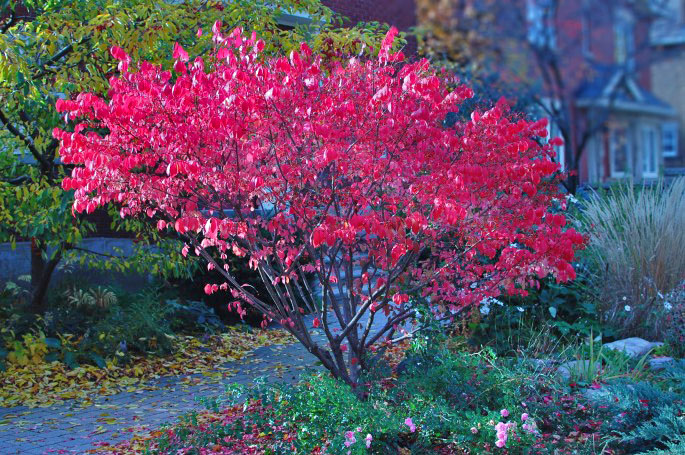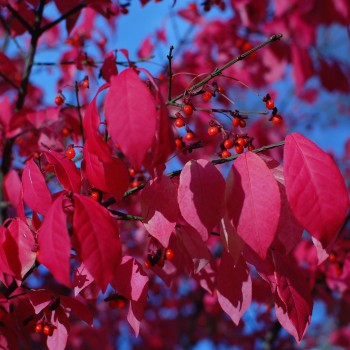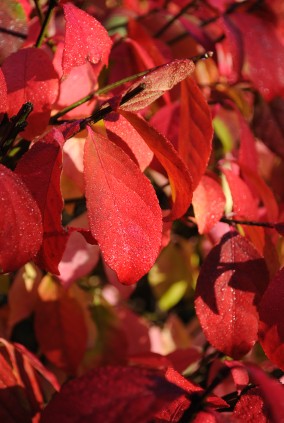Plant Profile: Burning Bush (Euonymus Alatus)
Many gardeners, dreaming of brilliant reds, turn to this hardy deciduous shrub for a splash of fall colour. Even in a drought-stricken year like this one, I couldn’t help but see them in many Ottawa gardens, with their flashy, fiery displays. They seem to be very popular in landscaping outside of shopping centres, in the suburbs particularly, brightening up some otherwise dull arrangements.
There are two main varieties: Euonymus alatus that can reach 15 feet in height and width, and the allegedly “dwarf” variety (Euonymus alatus compactus) that can get to be 8 – 10 feet high and wide. All have branching summer foliage of a medium green, and four interesting cork ridges that grow along the younger stems, giving it its Latin name “alatus”, which means “winged”. This shrub is also referred to as the winged burning bush. It has vivid red berries to go with the red leaf colour in fall. The red colour seems to vary with the cultivar, from an orangey red to a deep cherry red to fuchsia. There are flowers in spring, but they are tiny, yellowish-green, and are barely noticeable.
There’s a lot to like about this plant if you’re a novice gardener like me. It’s easy to care for, loving sun but tolerating partial shade, and is not too fussy about water as long as the soil stays reasonably moist. It apparently prefers very slightly alkaline soils, but as long as the soil pH isn’t too acidic it does well, thriving from pH 6.1 to 7.8. Best of all, it survives in areas as cold as Canadian zone 5a (USDA Zone 4a) without needing protection.
Another advantage is that the burning bush is tolerant of pruning, and can be shaped to accommodate a variety of garden spaces as an accent plant. It can be pruned to resemble a small tree, if you start when it is young. With lovely dense foliage, it is suitable for topiary treatment, and can make a great hedge when planted in a row. It does well as a container plant in warmer climates.

A burning bush as a front garden accent plant – with thanks to Pat Russell for permission to photograph her garden.
However, there are some drawbacks with this plant that you should know about before you consider planting one in your garden – at least in some areas. Originally from northeastern Asia (found in eastern Russia, China, Korea and Japan), the burning bush is not native to North America. It is in fact highly invasive in the northeastern United States, especially Massachusetts, Pennsylvania and Connecticut. It spreads mostly from the seeds of garden plants, which are dispersed by birds in their droppings to a wooded area or roadside. Once established, these plants can quickly take over and become very hard to remove, as it can also spread through suckers and form dense clumps. Here in Ottawa (Canadian gardening zone 5.a, US zone 4a) where it’s much colder, I don’t think it’s a problem; as I haven’t seen it growing in wild areas at all.
In my own attempts to shape the tree, I’ve noticed that the growth pattern of the burning bush is irritatingly uneven. Instead of each branch sending up new shoots every spring one or two will send longer shoots every year and the other branches take more time to catch up. New growth is also rather fragile and is easily knocked off. Patience is required if you’re trying to grow it into an interesting shape.
Unfortunately for burning bushes, they are tasty to a variety of wildlife. Deer will merrily devour the foliage, so if you live in a rural area you may want to choose another plant. Their bark also seems to be particularly tempting to rabbits, squirrels, and other rodents – the stem of mine seems to have fresh chew marks on it all the time, even though I’m in the suburbs, and I’ve read similar complaints on gardening forums. This tough little plant seems to bounce back nicely from these attacks, however. It is susceptible to typical insect pests like aphids, spider mites and scale insects, but not overly so.
I must at this point confess that I am a disappointed with my burning bush, and I am considering removing it. The problem is that while hardy, getting the right fall colour from it is not always easy. To get that beautiful vivid red, you need plenty of strong sunlight and enough water. Burning bushes need well-drained soil, but you cannot let them get as dry as you would some other plants – they’ll survive, but you won’t get the fall show. Instead, you’ll end up with fall colour that’s more of a washed out pink. Cruising through some American gardening blogs I notice they seem to get more of that deep scarlet I was looking for when I first planted my shrub. I get strong Southern sun all day long, but have not seen the colour I was looking for in the last four or five years – this year most of the leaves did not turn at all.
Still, if live in a very cold area and you’re looking for a low maintenance plant that will give you a touch of unusual colour in the fall, you may want to consider giving it a try – you may have better luck!
by Jennifer Priest
Follow me on Google +





No comments yet.
Add your comment